 BOBBY STEWART
.
August 22, 2023
.
F100 Builders Guide
BOBBY STEWART
.
August 22, 2023
.
F100 Builders Guide
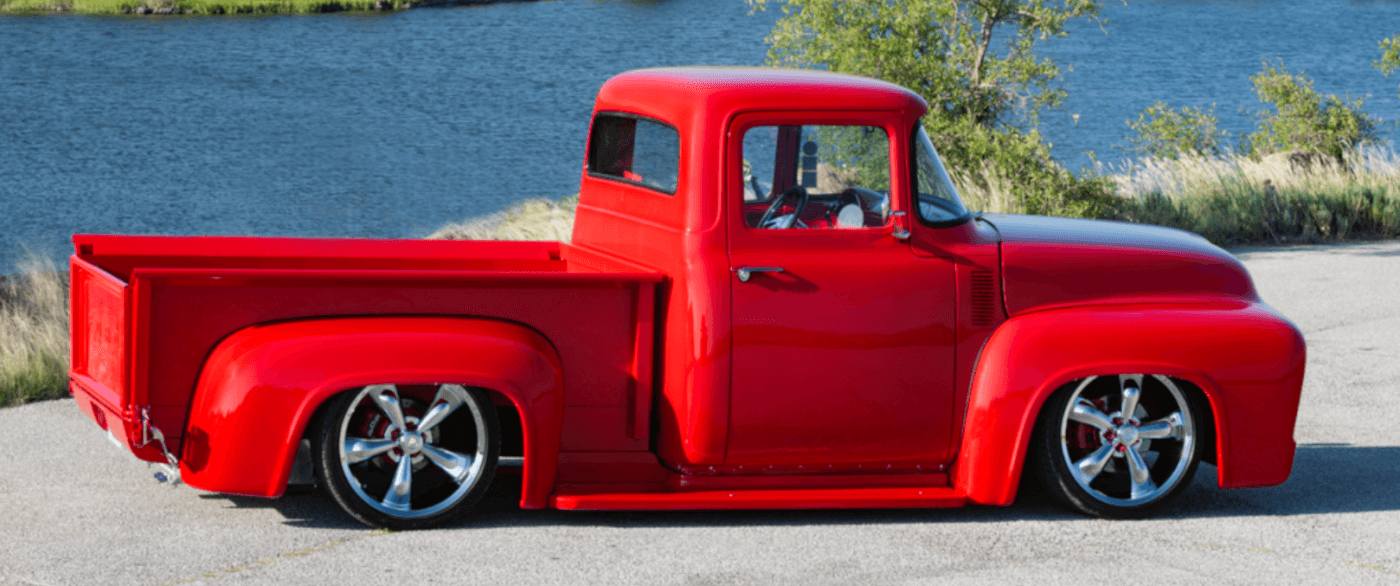

In our quest to bring readers new features each month, the staff here at Street Trucks constantly searches for stories that not only provide the best content for the magazine, but also inspire our readers.
Yes, we understand that dropping $50K-$100K on a truck build is simply not feasible for the majority of us, but when we come across two unbelievable Ford trucks from the same area in Oklahoma, it’s only fitting that we show our readers the level of success you can achieve by not being afraid to take a chance on building your own truck. Simply put, these Fords are the final reward for countless hours of hard work and determination invested by two guys with DIY attitudes and endless motivation.
When we first met Addison Augusta, it was very clear that we not only shared the same passion for custom trucks, but also the desire to be the driving force behind every aspect of the builds.
Addison summed up his feelings quite simply by saying, “Just a guy who built his own trucks. To me, it seems like it’s rare to find people who build their own cars anymore.”
While it is true that this Ford fall somewhere within the same build budget spectrum, the road Addison took to get there was quite different. In the end, he managed to build head-turning custom truck without breaking his bank account.
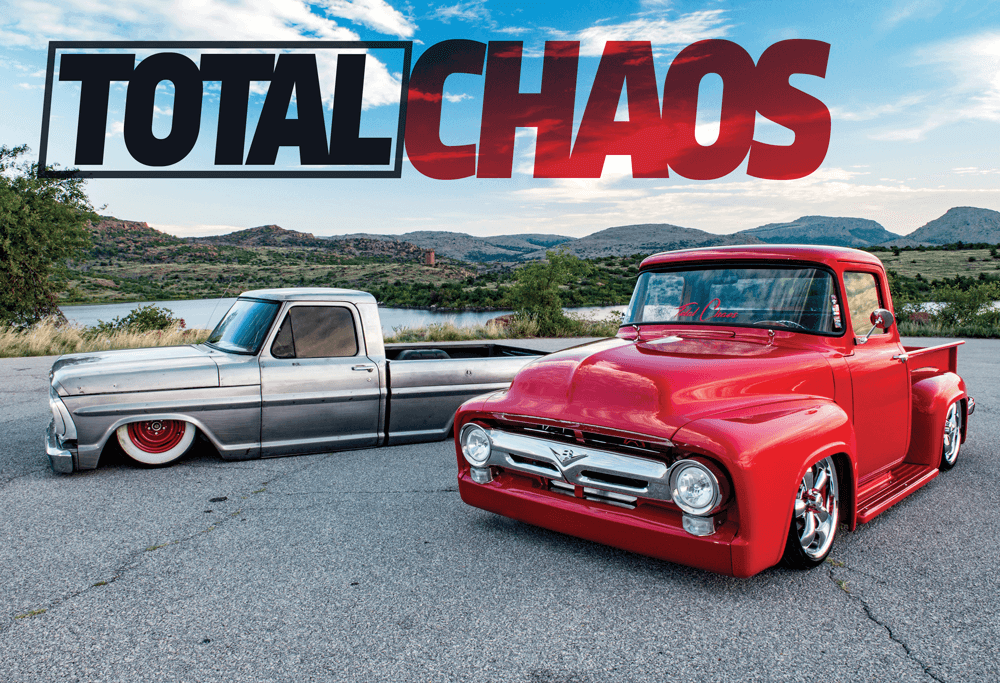
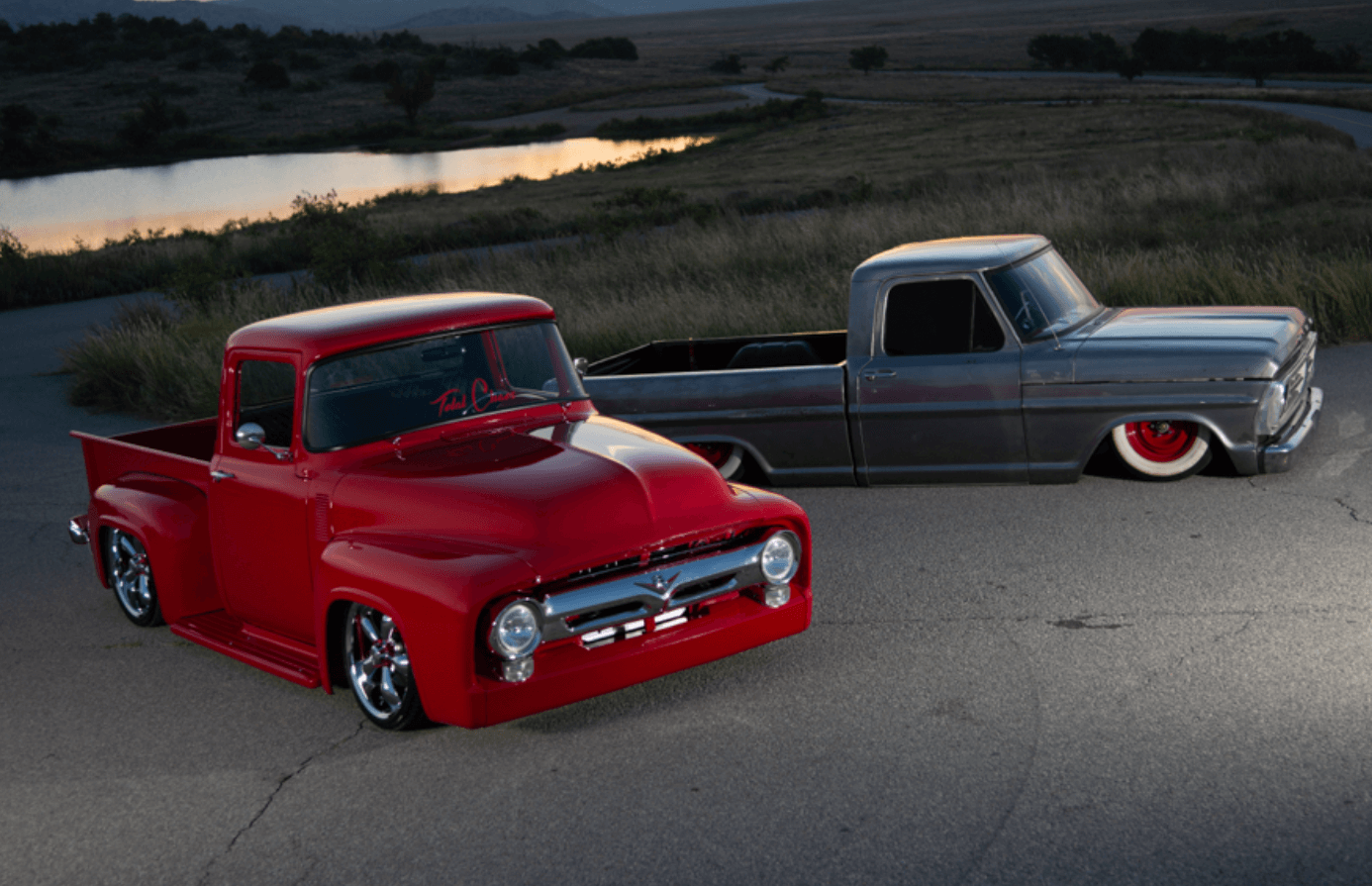
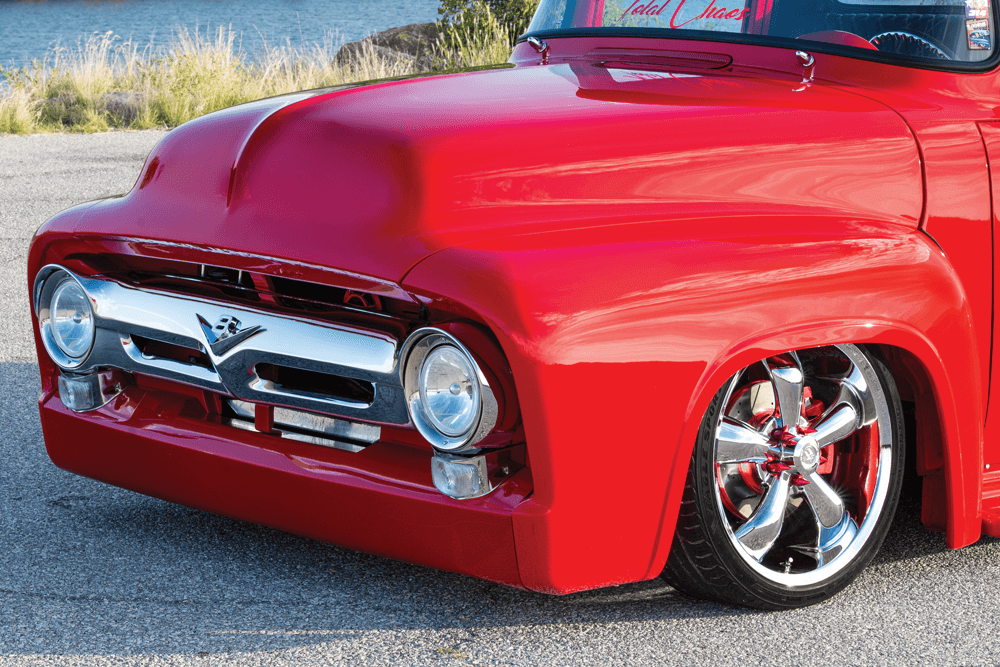
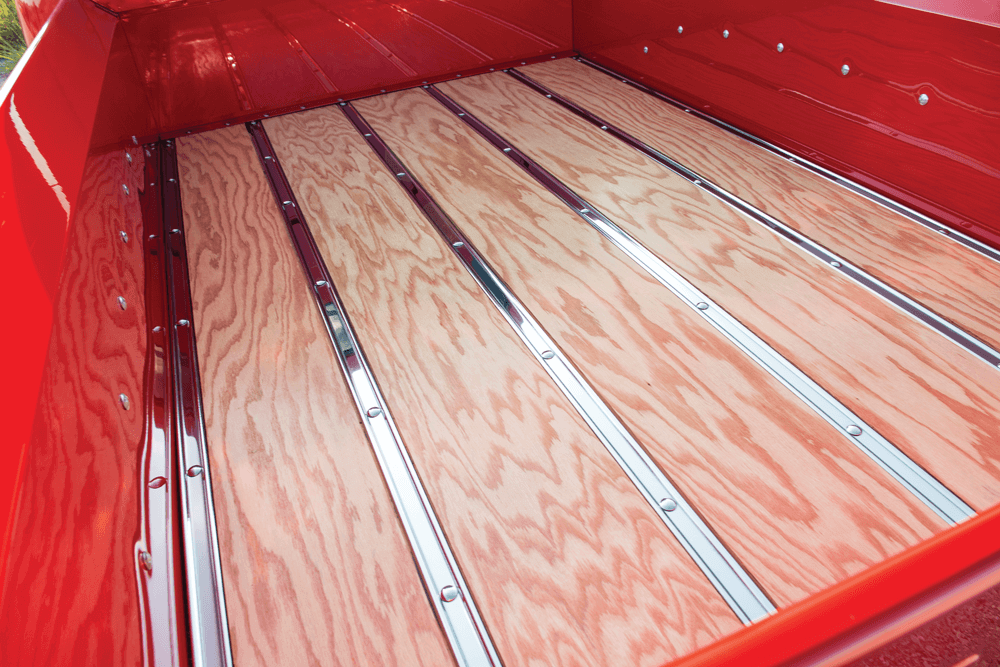
It was Sunday morning when Addison Augusta received the call that lead to a chance meeting and ultimately an offer that he would not be able to refuse.
“My mom called me to help move a China hutch that a friend was giving her,” the Cache, Oklahoma, resident recounted. “I get there, and I see an Olds 442 in the driveway.”
Eventually, Addison met the owner of that Olds, an older gentleman, who mentioned to Addison that he had one project too many—namely a 1956 Ford F100. He also mentioned that he had a few “extra parts” to go along with it, but there was a catch. The truck was in countless pieces and needed to be completely rebuilt.
Addison left agreeing to think it over. He wasn’t necessarily “in the market” for a Ford truck, after all. But the offer seemed too good to pass up, and Addison quickly found himself returning, this time with a trailer in tow. Once they began to load the trailer things took an even better turn when the previous owner revealed that he had been stockpiling parts to restore the Ford and would even follow home Addison with his own trailer full of extras.
Without doubt, the most eye-catching feature of Addison’s Ford is the bright red paint. For this he turned to Justin Byrd at Byrdman Kustomz in Lawton, Oklahoma, for assistance.”
Over the next year, Addison sorted through the parts, selling the ones that didn’t fit his style and buying new parts that did. He also picked up a donor 2003 Ford Crown Victoria Police Interceptor that he intended to use for the suspension and drivetrain.
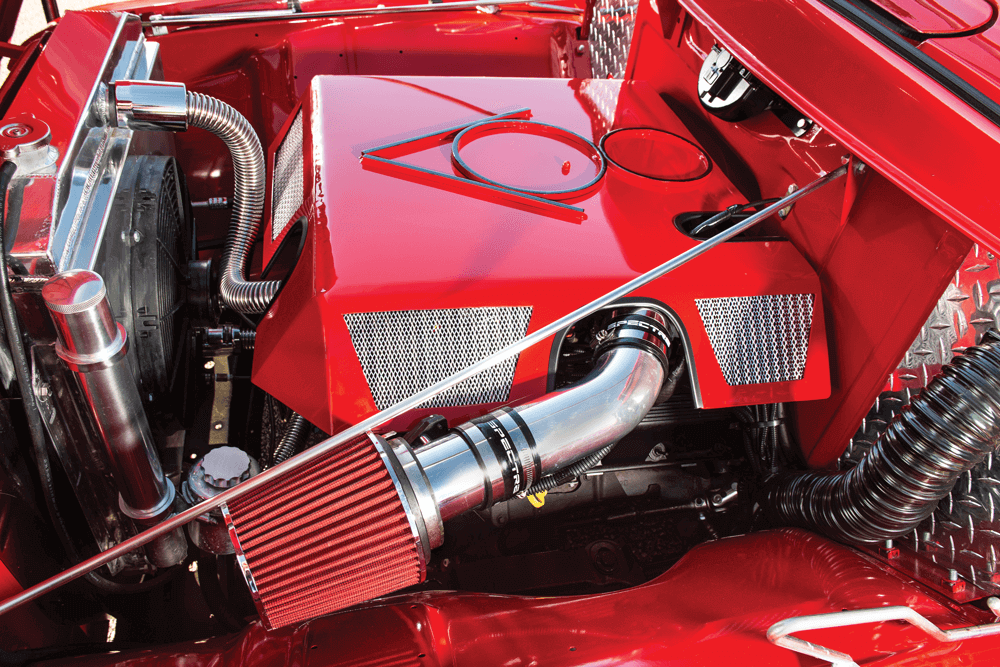
Within a year, Addison was ready to start building and turned to his own backyard to do so. “Built not bought” is not just a quirky catch phrase to Addison, but something he takes great pride in. He doesn’t own a commercial shop or car bay, just a basic garage to build the truck of his dreams. He says building the majority of his own truck gave him a sense of pride.
“I did this and I am proud of it,” he says, quickly adding, “At the end of the day, I guess I’m really just cheap!”
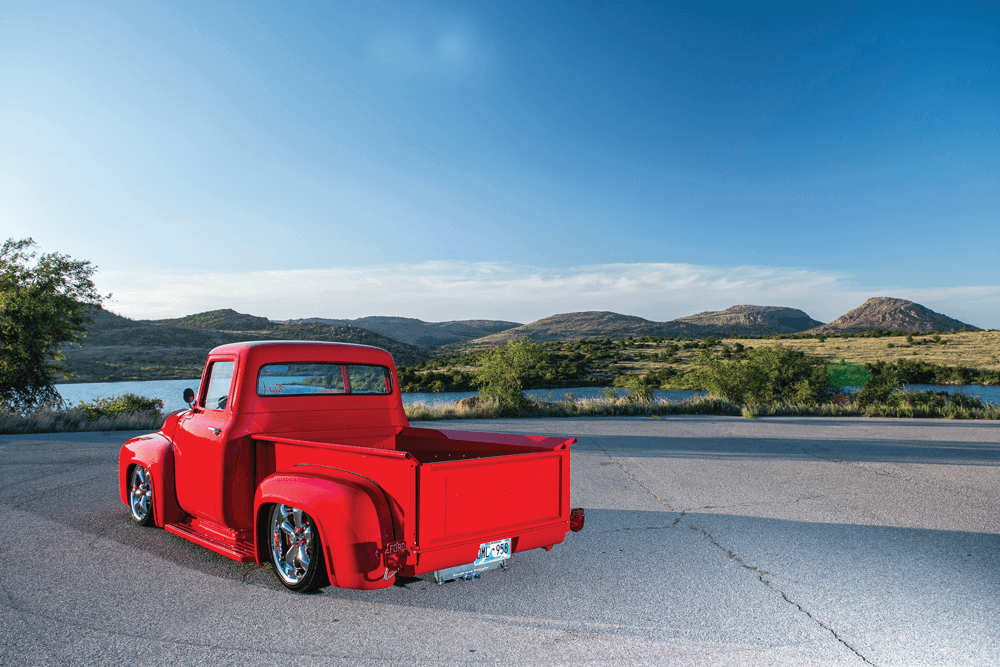
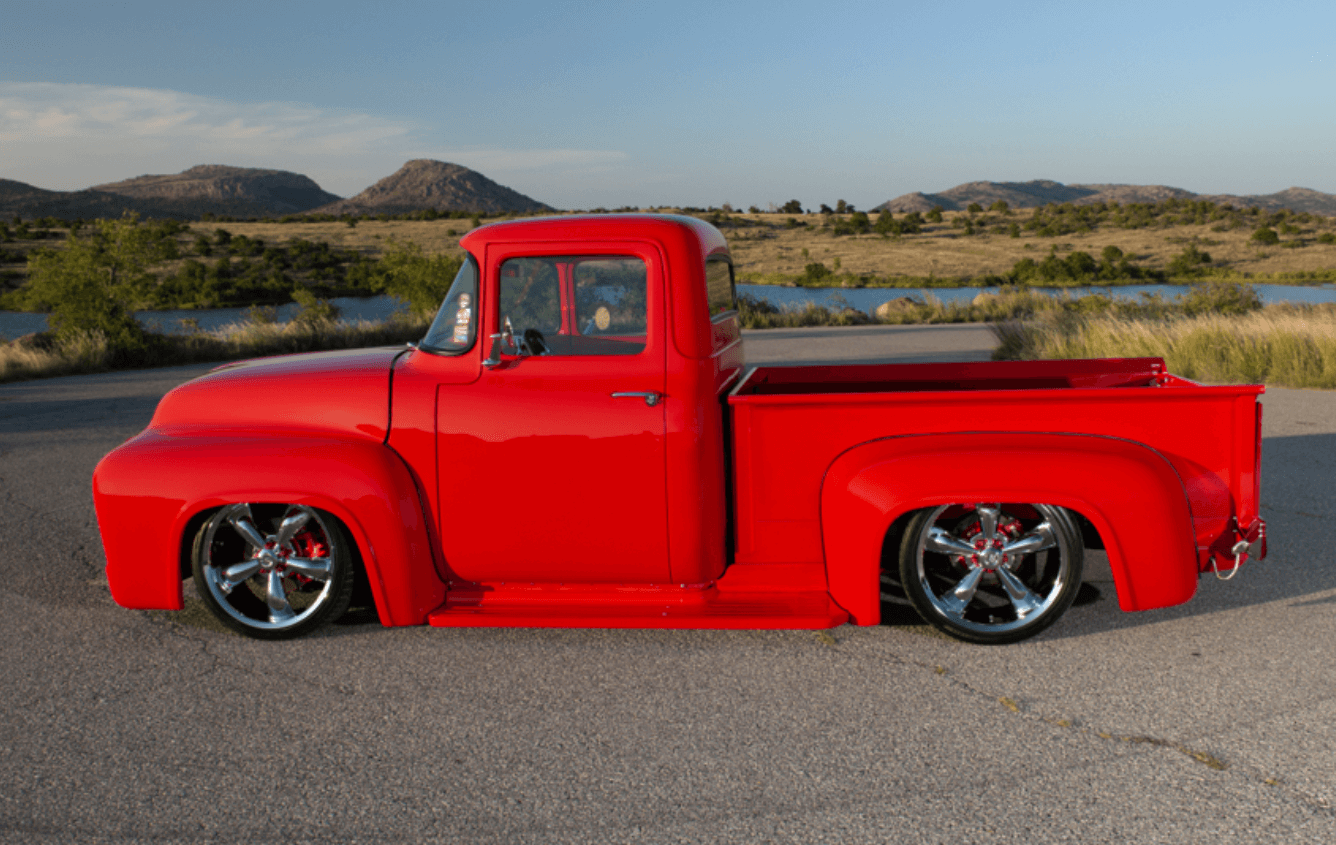
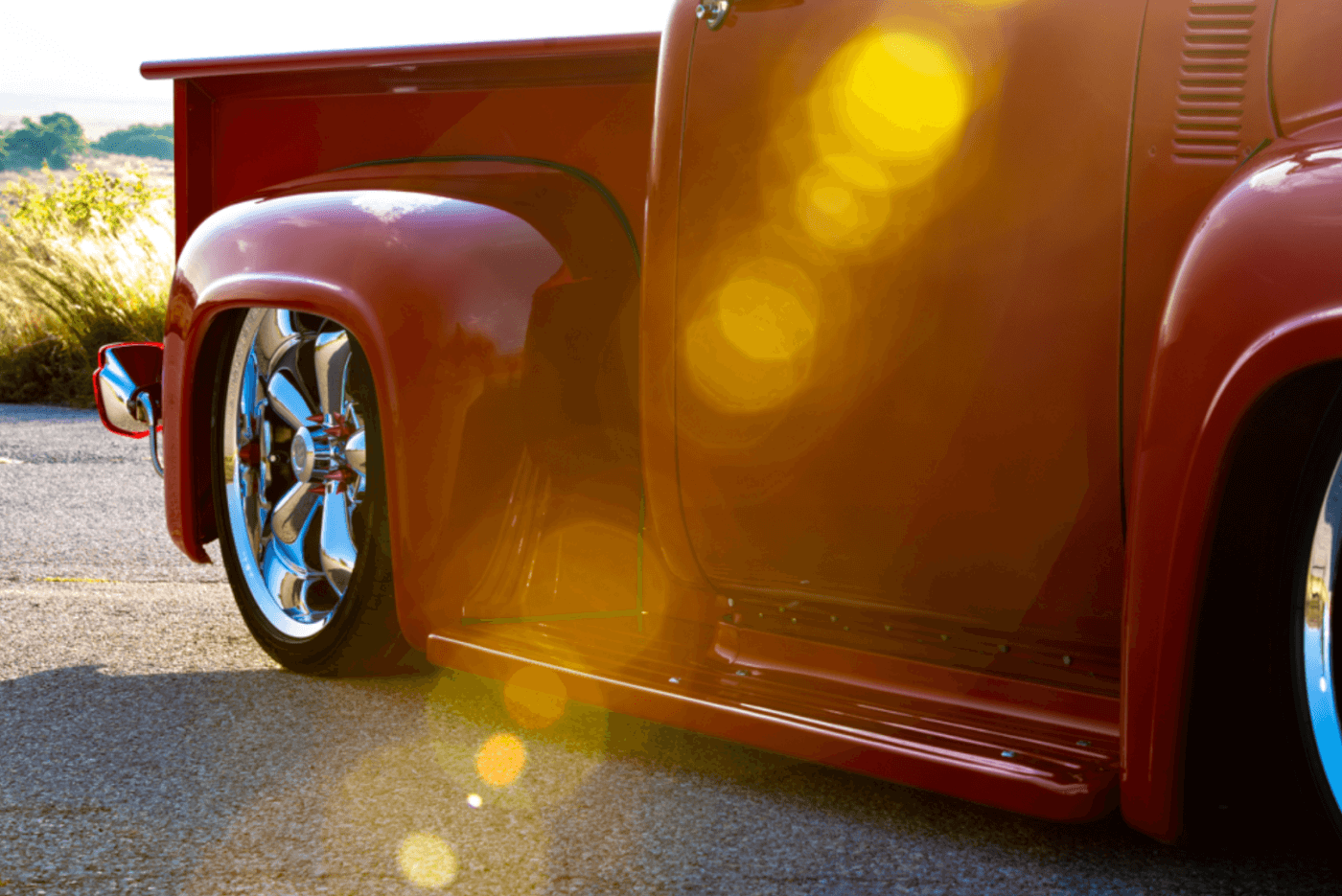
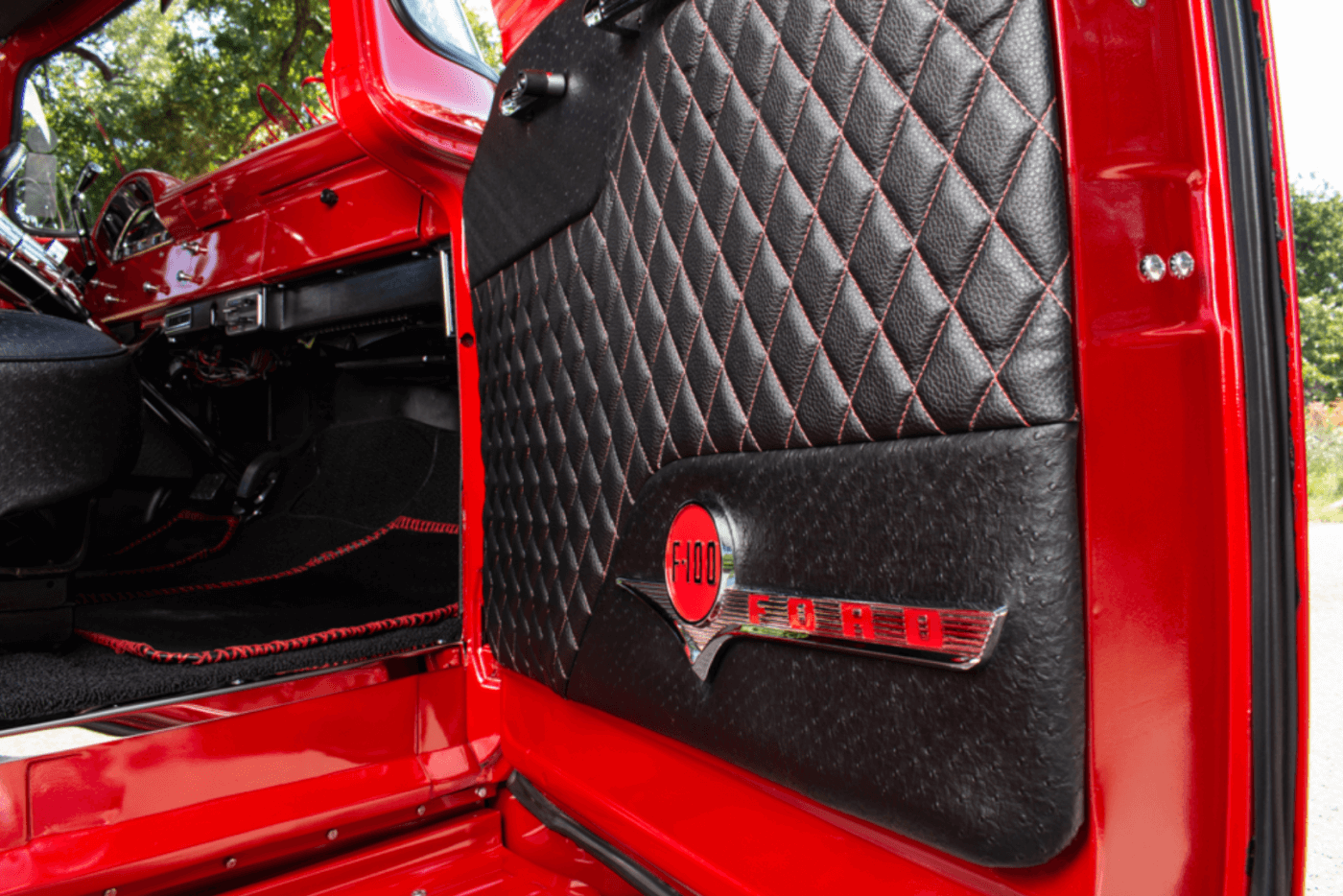
Addison tore the truck completely down to the frame, boxed in the back and cut off all of the “extras” before sandblasting. He grafted the front end from the donor Crown Victoria and used a universal triangulated 4-link on a 1997 Ford Explorer rear axle. The rebuilt and freshly repainted frame rides on RideTech Shockwave airbags with 3/8-inch Slam Specialties valves controlling the ride height. Addison then pulled the 4.6-liter engine and transmission from the Crown Victoria to prep and install. He handled the motorwork himself by refreshing and repainting it so he’s sure it’s reliable. The final step was to mate it back to the freshly rebuilt transmission thanks to Rick Garner’s Transmission Shop.
Addison also handled the body work himself, replacing floor pans, rockers, cab corners and shaving items such as the gas tank hole, antenna, keyholes and drip rails. The original truck had a lot of rust, so he spent many hours cutting, welding and grinding. The Ford features tilt bed and forward tilt hood to help better display Addison’s work and craftsmanship.
Without doubt, the most eye-catching feature of Addison’s Ford is the bright red paint. For this he turned to Justin Byrd at Byrdman Kustomz in Lawton, Oklahoma, for assistance. The original idea called for a two-tone paint scheme, but after a lot of second guessing, Addison kept it simple with Race Red. Justified Details of Lawton, Oklahoma, then added ceramic coating that brought out the Race Red base to an entirely different level.
“I really think the coating makes it pop,” Addison says. “When I built the truck, I built a driver. After we got the truck back from paint, it turned into a show truck.”
Since entering the show circuit, Addison’s Ford has managed to walk away with several “Best of” awards, including several for Best Paint.
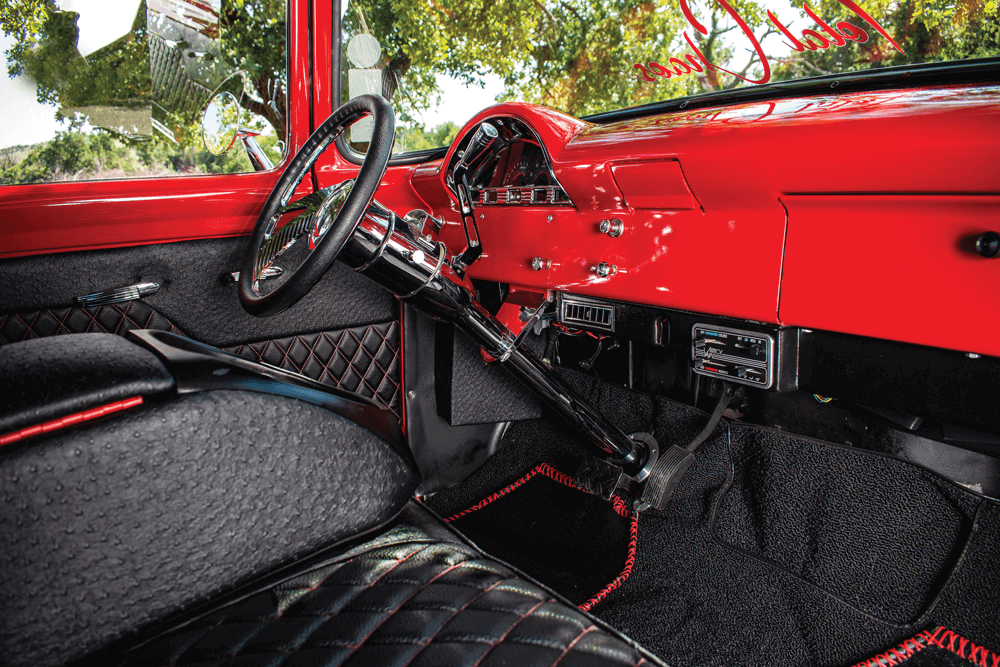
Early on, Addison was content with the original interior that came with the truck, but the black tuck and roll was fading and not up to the same level as the rest of the truck. It needed to be replaced. For this, Addison sketched his own design and asked JC’s Upholstery in Snyder, Oklahoma, to stitch it for him. The Ford’s interior has a very classy feel with black ostrich and red diamond tuck as the main theme, accented by a painted dash and billet and chrome throughout the cab.
With the truck now completely back together and quickly gathering attention both online and at shows, Addison has simply been enjoying the fruits of his labor.
“I took a truck that was laying on the side of the house, in pieces, and completed it,” he told us.
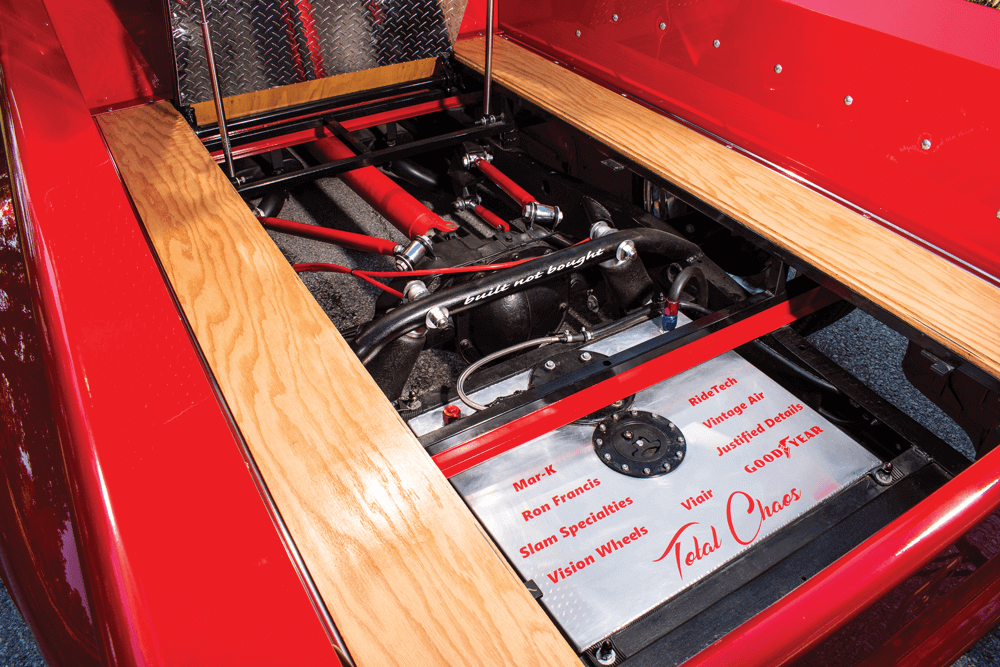
But, Addison is not finished by any means. He has future plans that include staggered offset wheels, wider fenders and airbrush work.
While Addison completed the majority of the build himself, he was quick to point out that he also had a lot help of others to complete it.
“Jessica, my wife, we do everything together,” he says. “We do all of our shows together. Ninety percent of the truck I built in the garage, but she would help me. She never complained. It makes is so much easier when you have somebody to support you.”
Addison also thanked Brandon Young for helping him with the electrical during the build.
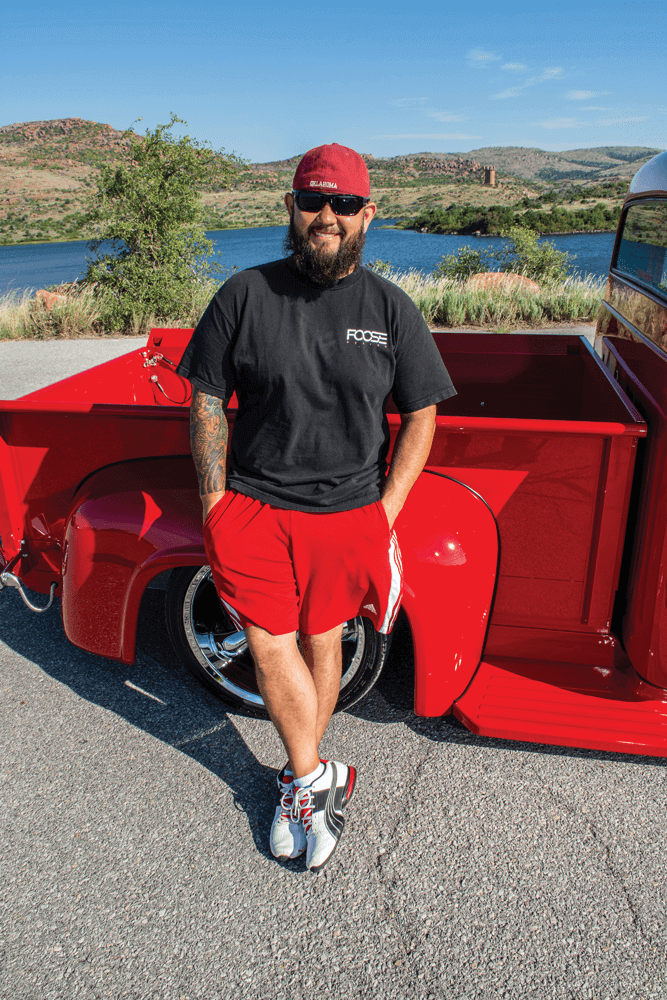
What are the benefits of supercharging a 1956 Ford F-100’s motor?
Supercharging a 1956 Ford F-100’s motor offers a myriad of benefits that can significantly enhance your truck’s performance and overall driving experience. Here’s a breakdown of the key advantages:
Supercharging your 1956 Ford F-100 can deliver impressive performance benefits, from increased horsepower and torque to improved engine efficiency and acceleration. It’s an upgrade that not only enhances your driving experience but potentially elevates the value and appeal of your classic truck.
What are some options for engine restoration or modification for a 1956 Ford F-100?
Restoring or modifying a 1956 Ford F-100 opens up a world of possibilities. Here are several options to consider:
If you aim to keep the truck as original as possible, restoring the engine to factory specs is a great choice. This involves:
For those looking to boost power and speed, consider turning the engine into a performance machine:
Swapping in a modern engine combines classic looks with contemporary performance:
For the ultimate in performance, consider forced induction:
Whether you choose to stick with classic authenticity, seek modern performance, or go for high-powered enhancements, the 1956 Ford F-100 offers numerous engine restoration and modification options. Each path provides its own unique benefits, from preserving nostalgic charm to achieving modern-day performance.
What types of superchargers are available for the Ford F-100?
Revamping your Ford F-100 with a supercharger can offer a significant boost in performance. If you’re considering this upgrade, it’s essential to understand the types of superchargers available. Here’s a helpful guide to the most common options:
Roots superchargers are famed for their robust design and instant power delivery. They sit atop the engine and force air directly into the combustion chamber. This type of supercharger provides immediate throttle response, making it a popular choice for enthusiasts seeking noticeable power gains right from idle.
Similar in mounting to Roots superchargers, twin-screw varieties also deliver immediate power. However, they are more efficient due to their screw-like compression mechanism. This results in cooler air temperatures and higher power output. Twin-screw superchargers are ideal for all-around performance improvements on your F-100.
Centrifugal superchargers function differently from the other types. Mounted to the front of the engine, they use a belt-driven impeller to force air into the engine. Unlike Roots and twin-screw types, centrifugal superchargers build boost more gradually, which can offer a smoother increase in power as RPMs climb. They are often favored for their efficiency and potential for high horsepower gains.
Though less common, electric superchargers are gaining traction. These units use an electric motor to drive the compressor rather than engine power. This can reduce the load on the engine and provide an alternative method to traditional belt-driven systems. Electric superchargers can be an innovative option if you seek a unique approach to improving your F-100’s performance.
Choosing the right supercharger depends on your driving needs and how you plan to use your Ford F-100. Each type offers distinct advantages:
Take the time to evaluate each option to find the best fit for your F-100. With the right supercharger, you can transform your truck’s performance and driving experience.
What wheels and tires are available for the Ford F-100?
When it comes to outfitting your Ford F-100 with the perfect wheels and tires, there’s a diverse range of options tailored to meet your needs. Here’s an overview of the available choices:
The selection of wheels includes a variety of types and accessories:
In addition to the wide wheel selection, there are 15 different tire options available. These encompass various sizes and tread styles, ensuring you can find the perfect tire for different driving conditions, whether you’re on the road or off the beaten path.
Both your wheel and tire selections should reflect your driving style, aesthetic preference, and functionality requirements. With plenty of options available, upgrading or replacing your Ford F-100’s wheels and tires has never been easier.
By choosing the right combination from this extensive selection, you can greatly enhance the performance, safety, and look of your Ford F-100. Happy driving!
How can a modern motor be integrated into a 1956 Ford F-100?
How to Integrate a Modern Motor into a 1956 Ford F-100
Integrating a modern motor into a 1956 Ford F-100 involves several key steps that can transform your classic truck into a high-performance machine.
Determine whether you want a motor that mirrors factory specifications or one that delivers enhanced performance. This will influence your choice of motor and additional modifications.
Select a modern engine that fits your performance expectations. Popular choices range from fuel-efficient, modern engines to high-performance options.
Ensure the engine bay is ready to accommodate the new motor. This might require:
Use compatible engine mounts designed for the new motor. Custom mounts may be necessary to ensure a secure fit.
Modern engines often come with advanced electronic systems:
Upgrade or adapt the transmission to match the new engine’s specifications:
Don’t overlook the supporting components:
Once installation is complete:
By carefully following these steps, you can successfully integrate a modern motor into your 1956 Ford F-100, blending classic design with contemporary performance.
What are some common issues to address when restoring a 1956 Ford F-100?
Restoring a 1956 Ford F-100 can be a rewarding project, but there are some common issues you’ll need to tackle to bring this classic truck back to life. Here are the most critical areas to focus on:
Over the decades, the suspension system of mid-century Ford pickups, including the F-100, can endure significant wear and tear. Inspect the leaf springs, shocks, and bushings for any signs of damage or deterioration. Replacing worn components will ensure a smoother and safer ride.
Rust is a notorious problem for vintage vehicles, and the 1956 F-100 is no exception. Pay special attention to the truck bed, cab corners, and fender wells. Rust can undermine the structural integrity of the vehicle, so consider replacing heavily corroded body panels or using rust treatment products to manage minor issues.
The old wiring in a 1956 Ford F-100 can be brittle and unsafe by today’s standards. Inspect the electrical system for frayed wires or outdated connectors. Upgrading the wiring harness can improve reliability and safety, especially if you plan on adding modern electrical components.
While robust, the original engine and transmission may require attention after decades of use. Check for any oil leaks, unusual noises, or poor performance. Consider a complete rebuild or swap for a more modern engine if you’re looking for enhanced performance and efficiency.
Safety should always be a priority, and that starts with the braking system. The original drum brakes may need thorough inspection and possible replacement with new drums or even converting to disc brakes for better stopping power.
Don’t forget the interior! The seats, headliner, and door panels often suffer from wear and tear. Reupholstering these elements can significantly enhance the comfort and visual appeal of your restoration.
Addressing these common issues will not only preserve the authenticity of your 1956 Ford F-100 but also ensure it’s roadworthy for years to come. Happy restoring!
What types of wheels are available for the Ford F-100?
When selecting wheels for your Ford F-100, you have a wide array of options to enhance both performance and aesthetics. Here’s a comprehensive look at the types of wheels you can consider:
Choosing the right wheels for your Ford F-100 is crucial for both performance and appearance. Whether you prefer the durability of steel, the lightweight benefits of alloy, the striking look of chrome, or the cutting-edge designs of custom wheels, there’s an option to suit every need. Consider your driving conditions, aesthetic preferences, and budget to make the best choice for your vehicle.
What types of tires are available for the Ford F-100?
When it comes to outfitting your Ford F-100, selecting the right type of tire is crucial for both performance and safety. Below are various tire options you might consider:
Types of Tires:
Selecting the right type of tire for your Ford F-100 can enhance your driving experience and extend the life of your vehicle. Whether you’re conquering rugged terrains or cruising on highways, there’s a tire perfectly suited to your needs.
What restomod parts are available for the Ford F-100?
Revamping your classic Ford F-100 with restomod parts can breathe new life into your vintage ride. From modern touches to essential upgrades, here’s what you can find:
Upgrading your Ford F-100 with restomod parts means marrying classic style with modern performance and convenience. Whether you’re looking to enhance the look, improve safety, or boost horsepower, there’s a vast range of options available.
What engine parts are available for the Ford F-100?
If you’re looking to upgrade or maintain your Ford F-100’s engine, there are a wide variety of engine parts available that cater to different needs. Here’s a comprehensive overview:
When shopping for engine parts for your Ford F-100, it’s essential to ensure compatibility with your specific year and model. Whether you’re performing routine maintenance or pursuing performance upgrades, there’s a vast selection of parts available to meet your needs.
What drivetrain parts are available for the Ford F-100?
If you’re looking to enhance or repair the drivetrain of your Ford F-100, there are numerous options available to you. Below, you’ll find a breakdown of the essential parts and components commonly available:
Key Drivetrain Components:
Supportive Accessories:
Upgrades and Performance Parts:
When selecting drivetrain parts, consider the following:
From robust transmissions and differentials to essential accessories and performance upgrades, you’ll find a comprehensive selection of drivetrain parts available for the Ford F-100. Each component is crucial for maintaining or enhancing your vehicle’s power and efficiency.
What are some common body and sheet metal parts for the Ford F-100?
The Ford F-100, a classic in the world of vintage trucks, has a plethora of body and sheet metal parts available for restoration, customization, and maintenance. Here’s a breakdown of some of the most common parts you’ll come across:
Fenders are crucial for protecting your vehicle from road debris, mud, and other elements. They’re often the first parts to show signs of wear and tear, making them a popular replacement item.
Over time, doors can suffer from rust or physical damage. Replacements are available to bring back the structural integrity and aesthetic appeal of your truck.
A new hood can dramatically alter the look of your F-100 while also ensuring the engine bay stays protected from the elements.
Whether you’re hauling cargo or just cruising, the bed panels can take a beating. Replacements help maintain functionality and overall truck condition.
These parts are prone to rust and can be easily replaced to keep the cab looking pristine.
Floor pans often succumb to rust and damage. Replacing them not only improves the truck’s appearance but also enhances safety.
Aside from providing protection, new bumpers can significantly improve the aesthetics of your F-100. They are available in various styles to fit your customization needs.
The grille is a focal point of the truck’s front end. Refreshing it or replacing an old emblem can make a world of difference in the vehicle’s appearance.
Frequently used and often damaged, a new tailgate can restore both functionality and style to the rear of your truck.
These panels are essential for the structural integrity of the truck. As they are often subjected to harsh conditions, replacements are commonly needed.
While not metal, weatherstrips are critical for sealing your truck’s body parts, preventing leaks and reducing noise.
These often-overlooked components play a significant role in driving safety. New mirrors and mounts can enhance both functionality and style.
By focusing on these key body and sheet metal parts, you can ensure your Ford F-100 remains in top-notch condition, combining both function and form in your restoration or maintenance efforts.
Why Are Ford’s Engines from the 1950s Considered Fun Restoration Projects?
Ford’s engines from the 1950s have earned a reputation among car enthusiasts for being particularly enjoyable to restore. Here’s why:
One major appeal is their straightforward design. Unlike modern engines, these classic powertrains are relatively simple to understand and work on. This ease of access makes them ideal for both novice and seasoned mechanics.
Another reason why these engines are so popular is their flexibility. You can easily bring them back to their original specifications if you’re aiming for a factory-fresh restoration. Alternatively, these engines serve as excellent foundations for performance upgrades. Consider adding high-performance parts from brands like Holley or Edelbrock to boost power and efficiency.
For those interested in mixing old with new, swapping in a contemporary engine is also a viable option. Upfitting your classic truck with a modern motor can provide the best of both worlds: the vintage appeal of a 1950s chassis combined with the reliability and performance of modern engineering. You could even add a supercharger to push the boundaries of what this classic vehicle can achieve.
In summary, the simplicity, customization options, and modern upgrade potential all contribute to making Ford’s 1950s engines a delightful and rewarding restoration project. Whether you aim for authenticity or high performance, these engines offer a range of possibilities to suit your passions.
What types of bumpers can be used on a 1956 Ford F-100?
When it comes to outfitting a 1956 Ford F-100, selecting the right bumper can make all the difference for both aesthetics and functionality. Here are some popular types you can consider:
Steel chrome bumpers are a classic choice for the F-100, especially if you want to maintain a vintage look. These bumpers are chrome-plated, offering a shiny, reflective finish that complements the truck’s vintage appeal. They are also durable and provide good protection.
For those seeking a modern touch, brushed aluminum bumpers offer a sleek and contemporary look. These bumpers are lighter than steel but still provide robust durability. The brushed finish is less flashy than chrome and more resistant to scratches and dents.
Powder-coated steel bumpers are designed for rugged use. The powder-coating process adds a layer of protection against rust and corrosion, making them an excellent choice for trucks that see a lot of action in harsh environments. These bumpers can be found in various colors to match or contrast with your F-100’s paint job.
If weight savings are a priority, fiberglass bumpers should be on your list. They are significantly lighter than metal bumpers, which can improve your truck’s fuel efficiency and handling. However, they may not offer the same level of protection as their metal counterparts.
For a truly unique look or specific functionality, custom fabricated bumpers are the way to go. These bumpers are tailor-made to fit your exact requirements, whether you need extra mounting points for accessories or a particular design to match your truck’s aesthetics.
Choosing the right bumper for your 1956 Ford F-100 involves balancing aesthetics, durability, and functionality. Whether you prefer the classic look of a chrome bumper or the modern appeal of brushed aluminum, there’s an option to suit every style and need.
What types of steering wheels are available for the Ford F-100?
If you’re looking to upgrade or replace the steering wheel on your Ford F-100, you’ll be pleased with the diverse options available. Here’s a rundown of the different types you might consider:
Perfect for those restoring vintage F-100s, classic steering wheels usually feature a timeless design, often with a wood grain finish or simple, elegant metal spokes. They bring back the nostalgia while maintaining authenticity.
These are tailored to your specific taste and can range from exotic materials like leather or carbon fiber to unique designs that include personalized logos or embroidery. They allow for maximum expression of individuality.
For drivers focused on enhanced driving experience and control, performance steering wheels offer a more ergonomic grip, reduced weight, and sometimes even a smaller diameter for quicker steering response. They often incorporate features like thumb grips and a flat bottom for better handling.
Designed to blend modern functionality with a retro look, these wheels are ideal for those wanting a vintage aesthetic with contemporary comfort and features. Expect to find modern materials and construction techniques wrapped in a timeless appearance.
Leather steering wheels are not only stylish but also provide a soft, comfortable grip. These are ideal for daily drivers who spend significant time behind the wheel and want both classic looks and modern comfort.
For a touch of elegance and classic appeal, wood grain steering wheels are hard to beat. They usually feature a polished wood finish, sometimes combined with chrome or brushed metal accents, adding both luxury and durability.
With these diverse options, you can find the perfect steering wheel to suit your style, driving preference, and restoration goals for your Ford F-100.
What types of intake manifolds are available for the Ford F-100?
When it comes to enhancing the performance of your Ford F-100, the type of intake manifold you choose can make a significant impact. Here’s a closer look at the different kinds available:
These are designed for high-performance applications. The single plane allows for quicker fuel and air mixture, making it ideal for racing and high-speed driving. This type typically operates best at higher RPM ranges, providing a substantial boost in horsepower.
Dual plane manifolds are often preferred for street driving. They have a split design that enhances low to mid-range torque. This makes them more suitable for everyday driving, offering a balanced performance across various speeds.
These are the go-to for drag racing enthusiasts. Tunnel rams feature large plenums and long runners, which are more efficient at very high RPMs. They significantly increase power but require a more specific tuning and engine setup.
For those looking to modernize their classic F-100, EFI manifolds are an excellent option. They offer better fuel management and efficiency, leading to improved performance and easier starts. Transitioning to an EFI setup can also enhance reliability and simplify maintenance.
Modular designs offer flexibility; you can customize them according to your performance needs. They often permit interchangeable components like different runner lengths or plenum sizes.
Here’s a quick benefits overview:
Your choice will largely depend on your specific driving needs and performance goals. Each type brings its own set of advantages, enabling you to get the most out of your classic Ford F-100.
What suspension parts are available for the Ford F-100?
When it comes to upgrading your Ford F-100, focusing on suspension parts can significantly improve the truck’s performance and ride quality. Here’s a breakdown of the essential suspension components you might consider:
Shocks and struts are fundamental to your truck’s suspension system. Upgraded shocks can provide a smoother ride and better handling. You’ll find options ranging from traditional hydraulic shocks to more advanced gas-charged varieties.
Both coil springs and leaf springs can be replaced or upgraded, depending on your driving needs. Tuning the spring rates can help adjust the truck’s stance and ride quality.
Upgrading control arms can improve handling and steering precision. Enhanced materials like tubular steel can make these parts more durable and performance-oriented.
Sway bars, also known as anti-roll bars, help reduce body roll during cornering. For an F-100, beefier sway bars can offer significant handling improvements.
Replacing old, worn-out bushings with polyurethane versions can improve the truck’s responsiveness. They offer a firmer, more connected feel to the road.
Depending on whether you want to drop your F-100 closer to the ground or lift it for off-road adventures, there are kits designed for either modification.
Lastly, don’t forget the smaller components like ball joints and tie rods. Keeping these parts in top condition ensures precise steering and overall suspension integrity.
Investing in the right suspension parts for your Ford F-100 can transform its driving dynamics and comfort. From shocks to control arms, and lowering kits to beefy sway bars, there’s a wide range of options to tailor your truck to your preferences.
What fuel tank options are available for a 1956 Ford F-100?
When it comes to replacing the fuel tank of a classic 1956 Ford F-100, several options cater to different needs and preferences. Here’s a closer look at available choices:
These tanks are designed to fit within the cab of the truck, maintaining the original configuration of the vehicle.
For those who want to free up space in the cab or prefer a different weight distribution, under-bed tanks are an excellent option.
For a tailored fit and specific requirements, custom fuel tanks can be fabricated.
These are direct replacements for the original fuel tanks but made with modern materials.
Updating the fuel tank of your 1956 Ford F-100 not only enhances its performance but also retains its classic charm. Consider these options to find the best fit for your restoration project.
What are some examples of bucket seat sets available for a 1956 Ford F-100?
Examples of Bucket Seat Sets for a 1956 Ford F-100
Looking to upgrade the seating in your 1956 Ford F-100? Here are some bucket seat options to consider:
By selecting the right bucket seat set, you can greatly enhance both the comfort and style of your 1956 Ford F-100.
What types of tools are available for maintaining the Ford F-100?
Maintaining a Ford F-100 requires a variety of tools, each tailored to specific tasks. Below is an overview of some essential tools you’ll need to keep your truck in top condition.
Maintaining a Ford F-100 involves using a comprehensive set of tools, including engine and transmission tools, electrical diagnostic equipment, brake and suspension tools, body and interior tools, general maintenance tools, and cleaning and detailing supplies. Each category of tools is essential for different aspects of the truck’s upkeep, ensuring your Ford F-100 remains reliable and looking its best.
What types of taillights are available for the Ford F-100?
When it comes to upgrading or replacing the taillights on your Ford F-100, you have several options. Here’s a breakdown of the various types of taillights you can choose from:
Whether you’re restoring a classic or upgrading for better performance and aesthetics, these options provide a wide range of choices to fit your needs.
What types of headers are available for the Ford F-100?
When it comes to upgrading your Ford F-100, one of the essential components to consider is the headers. These parts are crucial for enhancing the exhaust flow and improving overall engine performance. Here’s a breakdown of the different types of headers you can find for the Ford F-100:
When choosing headers for your Ford F-100, it’s essential to verify compatibility with your specific engine type and overall vehicle setup. Ensure that the headers you select match the engine displacement and accommodate any aftermarket modifications you may have.
Upgrading the headers on your Ford F-100 can significantly boost performance and provide a more aggressive exhaust note. Whether you’re looking for daily driving improvements or high-end power gains, there’s a header option to meet your needs.
What types of carburetors are available for the Ford F-100?
When it comes to upgrading or replacing the carburetor on your Ford F-100, you have a variety of options to choose from. Each type has its own advantages, depending on your needs for performance, fuel efficiency, or ease of maintenance.
Single-barrel carburetors are often found in older models of the Ford F-100. They are simple, reliable, and relatively easy to tune. Ideal for those who use their trucks for basic, everyday driving.
If you’re looking for a balance between performance and fuel efficiency, a two-barrel carburetor may be your best bet. These offer improved fuel distribution and can provide a modest boost in horsepower compared to single-barrel options.
For those aiming to maximize performance, four-barrel carburetors are the way to go. These carburetors can significantly enhance your engine’s horsepower and torque, making them perfect for high-speed driving and heavy-duty tasks.
Modern replacements often come with electric chokes that provide more convenience and better cold-start performance. These carburetors automatically adjust the choke, making them user-friendly and efficient.
Manual choke carburetors offer greater control over your vehicle’s fuel-air mix, especially during start-up. While they may require more hands-on management, they can be tuned to offer specific performance gains.
For those looking to take their F-100 to the next level, high-performance carburetors provide enhanced airflow, leading to significant increases in horsepower and acceleration. These are ideal for racing or other high-stress applications.
With such a variety of carburetors available, upgrading your Ford F-100 can be tailored precisely to meet your specific performance or maintenance needs. Happy driving!
What tools and supplies are useful for maintaining the Ford F-100?
Maintaining a classic Ford F-100 requires a diverse set of tools and supplies. Whether you’re performing routine maintenance, upgrading parts, or tackling a restoration project, having the right equipment is critical. Here’s a comprehensive guide to some tools and supplies you might need for your Ford F-100:
Proper maintenance of your Ford F-100 involves a mix of routine tasks and occasional upgrades. Whether you’re a weekend warrior or a seasoned mechanic, having the right tools and supplies will make your work easier and more effective. Always keep your toolbox well-stocked and continuously update your inventory to tackle any maintenance or restoration project that comes your way.
What stripes and decals are available for the Ford F-100?
When customizing your Ford F-100, adding stripes and decals can make a significant difference in its appearance. Here is a list of available options you can choose from to elevate the look of your classic truck:
With these options, you can easily find the perfect stripes and decals to customize your Ford F-100 and make it uniquely yours.
What steering components are available for the Ford F-100?
When upgrading or maintaining your Ford F-100, understanding the variety of steering components available is essential. Here’s a breakdown of what you might need:
The steering box is a crucial component that translates your steering wheel’s motion into the movement of your vehicle’s wheels. Modern upgrades can provide more responsive handling and a smoother ride.
Steering columns are integral to the connection between the steering wheel and the rest of the steering system. You can choose from a range of styles and materials to match your vehicle’s interior aesthetic. Trim pieces can also be added to enhance the look and functionality.
These components connect the steering column to the steering box, ensuring that your inputs are accurately transferred. High-quality steering shafts can reduce play and improve overall steering precision.
Mounting kits are necessary for attaching aftermarket steering wheels. They ensure a secure fit and often include all the hardware required for installation.
This category includes everything from horn buttons to adapter kits and spacers. Customizing these parts can refine your driving experience and add a personal touch to your interior.
Whether you’re looking to replace a worn-out original or upgrade to a more modern design, steering wheels come in a variety of styles. Choose from classic wooden wheels, sporty designs, or ergonomic models to suit your driving needs.
By understanding these key components—steering boxes, columns, shafts, mounting kits, parts, and wheels—you’ll be well-equipped to enhance the steering system of your Ford F-100. Each component plays a vital role in ensuring your vehicle handles smoothly and safely, giving you both performance and peace of mind.
What lighting components are available for the Ford F-100?
When it comes to lighting components for the Ford F-100, there’s a broad array of options to choose from. Whether you’re looking to enhance visibility, upgrade aesthetics, or replace faulty parts, here’s a comprehensive list of available lighting components:
In summary, the Ford F-100 lighting components range from essential replacements to high-performance upgrades, covering all aspects of visibility and safety. Whether you are maintaining your classic truck or giving it a modern touch, numerous options are available to meet your needs.
What types of accessories are available for the Ford F-100?
When it comes to accessorizing your Ford F-100, you have a broad array of options to both enhance performance and elevate aesthetics. Here are some categories of accessories you can consider:
Air Suspension
Automatic Upgrades
These categories highlight the extensive range of accessories available for the Ford F-100, each aimed at augmenting the truck’s functionality, performance, and style. Whether you’re looking to perform minor tweaks or complete restorations, the options are vast and varied.
What is the Ford F-100 Explorer Special?
The Ford F-100 Explorer Special was designed as a limited edition version of the classic F-100 pickup truck, making it one of the few special trims available during its time. This unique package added a touch of luxury and distinction to the otherwise utilitarian vehicle, offering a visually striking alternative to the standard model.
Key Features of the F-100 Explorer Special:
This special trim package not only catered to the hardworking individual who needed a reliable pickup but also appealed to those looking for something with a bit more flair and exclusivity.
What is the history of the Ford F-100?
The Ford F-100 stands as a significant chapter in the legacy of American pickups. Launched in the early 1950s, the F-100 quickly became a symbol of durability and performance. It featured a robust design, making it a popular choice among farmers, tradespeople, and everyday drivers looking for a reliable vehicle.
Throughout its production, the F-100 influenced many subsequent Ford pickup models. Its blend of strength and accessibility set a precedent, leading to its favor in numerous industries. The truck maintained a balance of functionality and style, which continued to attract a wide customer base until production ceased in the mid-1980s.
Although the F-100 quietly exited the market in the 1980s, its impact remains evident. The principles of reliability and innovation that it embodied paved the way for future Ford trucks, securing their place as a staple in the pickup market. The enduring popularity of later models can, in part, be traced back to the solid foundation established by the F-100.
In summary, the Ford F-100’s history is marked by continuous improvement and lasting influence, cementing its role in shaping the future of pickup trucks in America.
What master cylinder kits are compatible with a 1956 Ford F-100?
If you’re looking to upgrade or replace the master cylinder on your 1956 Ford F-100, there are several options available that ensure compatibility and improved performance. Here are some top choices:
These kits are tailored to fit vintage Ford trucks, ensuring you get both functionality and reliability. Make sure to double-check the specifications and choose the kit that best meets your needs for your classic 1956 Ford F-100.
What door latch assemblies are available for a 1956 Ford F-100?
If you’re restoring a 1956 Ford F-100, the door latch assembly is a crucial component that ensures your vehicle’s doors open and close smoothly. Here are some top options available:
These assemblies are designed to replicate the original equipment manufacturer (OEM) specifications, providing an authentic fit and finish. They are ideal for those looking to maintain the truck’s classic look.
For enhanced durability and performance, consider aftermarket upgraded door latch assemblies. These often feature modern materials and engineering improvements to withstand wear and tear better than the original designs.
Custom-fit door latch assemblies are tailored to fit the specific dimensions and requirements of your 1956 Ford F-100. These options can be more accommodating for unique builds or modified door designs.
Several reputable third-party brands produce high-quality door latch assemblies compatible with a 1956 Ford F-100. Here are a few options:
You can find door latch assemblies ranging from affordable options starting at $75 to more premium choices that might be priced higher depending on the brand and features.
These door latch assemblies are available from various automotive parts suppliers, including specialized classic truck retailers and general auto part stores. Online marketplaces can also offer competitive pricing and a broad selection.
By choosing the right door latch assembly for your 1956 Ford F-100, you can ensure your restoration project is both functional and true to its original design.
What options are there for steering wheels for a 1956 Ford F-100?
Upgrading the steering wheel of your classic 1956 Ford F-100 is an excellent way to enhance both its functionality and aesthetic appeal. Here are some options to consider:
Woodgrain steering wheels are a popular choice for vintage vehicles, offering a nostalgic look and feel. These wheels often come with either 3-bolt or 9-bolt hubs and feature various spoke designs, from slotted to fully holed spokes. Available sizes typically include 14″ and 15″.
For those seeking a modern touch while retaining a classic vibe, simulated leather steering wheels are a great option. These typically feature a 14″ diameter and are available in different spoke designs, including slotted and 4-spoke configurations.
If you’re looking for something a bit more upscale, walnut and mahogany steering wheels can add a rich, luxurious feel to your F-100. These wheels often come in various bolt patterns to match different hub types.
For a more understated but equally stylish option, consider black simulated leather combined with stainless steel spokes. These types of steering wheels often come in 14″ sizes, and feature slotted or holed spoke designs.
There are also steering wheels designed to replicate specific styles, such as the GT350-style billet aluminum wheels, which feature woodgrain and a polished finish.
When choosing a steering wheel for your 1956 Ford F-100, keep in mind the following:
By examining these options, you can find the perfect steering wheel that not only complements your 1956 Ford F-100 but also enhances your driving experience.
What types of radiators are available for the Ford F-100?
When it comes to the Ford F-100, you have several options for radiators, each catering to different needs and preferences. Here’s a breakdown of the most common types:
Copper/brass radiators are considered the traditional choice. Known for their excellent heat dissipation, these radiators are durable and easy to repair if damaged. They are a reliable choice for maintaining vintage or classic Ford F-100s.
Aluminum radiators offer modern efficiency with lightweight construction. These radiators often provide superior cooling performance compared to copper/brass models. Their resistance to corrosion is another advantage, enhancing longevity and reliability. Ideal for upgraded or high-performance trucks, aluminum radiators are a popular choice for those looking to improve overall engine efficiency.
Specifically designed for enhanced cooling, performance radiators are typically made from high-quality aluminum. They often feature larger cores and improved designs to maximize airflow and cooling capacity. These are an excellent choice for Ford F-100s that are used for towing, off-roading, or high-speed driving.
OEM (Original Equipment Manufacturer) radiators are designed to match the specifications of the factory-installed radiators. These are perfect for those looking to preserve the originality of their Ford F-100 while ensuring top-notch performance. They fit perfectly without any modifications and offer reliable performance.
For those who need a radiator that fits unique or modified setups, custom radiators can be tailored to specific requirements. These radiators offer the flexibility to accommodate engine swaps, special cooling needs, or custom chassis configurations. They allow for precise control over cooling performance and fitment.
When selecting a radiator for your Ford F-100, consider factors such as your truck’s usage, engine type, and any performance modifications. Each type of radiator has its benefits, so determining what best fits your needs will ensure optimal cooling and performance.
Whether you’re restoring a classic or boosting performance, there’s a radiator option that perfectly suits your Ford F-100. Explore your choices and keep your engine running cool!
What types of ignition coils are available for the Ford F-100?
When it comes to upgrading or replacing the ignition coils in your Ford F-100, you have several options to choose from that cater to different performance levels and requirements. Here are the primary types of ignition coils you might consider:
Standard ignition coils are designed to meet or exceed OEM specifications. They offer reliable performance for everyday driving conditions. These coils are an excellent choice if you’re looking to maintain the same level of functionality as the original parts.
For those looking to boost their engine’s performance, performance ignition coils are a great option. These coils provide a stronger spark, which can lead to more efficient combustion, better throttle response, and potentially increased horsepower.
Coil packs are a modern alternative to traditional ignition coils. Each coil pack services a specific cylinder, which can improve spark delivery and engine response. They are often used in higher-performance engines and are known for their reliability and efficiency.
Dual spark ignition coils feature two spark plugs per cylinder, which can enhance combustion and improve fuel efficiency. These coils are beneficial for achieving smoother engine performance and reducing emissions.
Some aftermarket ignition coils come with advanced features like multi-spark discharge (MSD) and capacitive discharge ignition (CDI) systems. These features can significantly enhance spark quality and provide better engine performance, especially in high-stress conditions.
High-voltage ignition coils are designed to deliver a more powerful spark, which is particularly useful for engines that require a high-energy ignition system. These coils can support higher RPMs and more demanding performance applications.
When selecting the right ignition coil for your Ford F-100, consider your vehicle’s specific needs and your performance goals. Whether you’re looking for a simple replacement or a significant performance upgrade, there are plenty of options available to keep your F-100 running smoothly.
Feel free to explore and compare these types of ignition coils to find the perfect fit for your vehicle!
What types of gauges are available for the Ford F-100?
When it comes to personalizing and enhancing your Ford F-100, upgrading the gauges can make a significant impact. Here’s a comprehensive look at the types of gauges you can choose for your classic truck.
With so many options available, you can tailor your Ford F-100’s dashboard to match your specific needs and style preferences. Whether you’re going for a vintage look or embracing modern technology, there’s the perfect gauge setup for you.
Upgrading your Ford F-100’s gauges not only enhances functionality but also adds a touch of personal style. Make sure to consider factors like ease of installation, accuracy, and the type of driving you’ll be doing when selecting your gauges.
What types of fuel pumps are available for the Ford F-100?
When it comes to enhancing the performance and reliability of your Ford F-100, selecting the right fuel pump is crucial. Here’s a comprehensive overview of the various types of fuel pumps available for this classic vehicle:
Mechanical fuel pumps are a staple in older vehicles, including the Ford F-100. These pumps are mounted on the engine and operate using a lever that is activated by the camshaft. They are known for their simplicity and durability, making them a common choice among vintage truck owners.
Electric fuel pumps are more modern alternatives that can be mounted either inside the fuel tank (in-tank) or outside (in-line). These pumps are electrically powered and provide consistent fuel pressure, which is ideal for high-performance engines.
High-pressure fuel pumps are essential for vehicles that require a significant amount of fuel delivery, especially those with performance modifications. They ensure that the engine receives the necessary fuel under high-demand situations, like racing or heavy towing.
Ideal for stock or mildly modified engines, low-pressure fuel pumps deliver fuel at a rate that matches the engine’s requirements without overwhelming the system. These pumps are typically less expensive and easier to install.
Universal fuel pumps are designed to fit a wide range of vehicles and can serve as a versatile option for the Ford F-100. They are available in various configurations, ensuring compatibility with different fuel systems and engine setups.
For those looking to boost the performance of their existing fuel system, inline booster pumps can be added to enhance fuel pressure and flow. These are typically used in conjunction with other fuel pumps to meet higher performance demands.
If your Ford F-100 has been modified to run on diesel, specific diesel fuel pumps are available. These pumps are designed to handle the unique properties of diesel fuel, providing reliable performance and durability.
Choosing the right fuel pump for your Ford F-100 depends on your specific needs and engine setup. Whether you’re restoring a classic model with a mechanical pump or upgrading to a high-performance electric pump, there are options available to ensure your truck runs smoothly and efficiently. Always consider your vehicle’s requirements and consult with a professional if you’re uncertain about which type of fuel pump best suits your F-100.
What types of exhaust tips are available for the Ford F-100?
When customizing a classic Ford F-100, one striking way to enhance its look and performance is by upgrading the exhaust tips. Here, we explore various types of exhaust tips available for this iconic truck:
When selecting an exhaust tip for your Ford F-100, consider the following aspects:
By exploring these options, you can find the perfect exhaust tip that not only enhances the look of your Ford F-100 but also potentially improves its performance.
What types of distributors are available for the Ford F-100?
When it comes to the Ford F-100, various types of distributors are available to suit different needs and preferences. Here are some of the main options:
Traditional point-type distributors are the classic choice. They use mechanical points and condensers to manage the ignition timing.
Upgrading to an electronic distributor provides more reliability and less maintenance compared to point-type models.
For those looking to enhance the performance of their F-100, performance distributors offer advanced ignition capabilities.
HEI distributors are popular due to their built-in coil and reliable performance.
No matter the type you choose, making the right selection depends on your specific needs, whether they are for restoration, daily driving, or performance upgrades.
What types of brake calipers are available for the Ford F-100?
When upgrading or replacing the brake calipers on your Ford F-100, you have a variety of options to choose from. Here’s a comprehensive look at the different types available:
When selecting brake calipers for your Ford F-100, consider factors like driving style, vehicle use, and budget. Whether you’re looking for basic replacements or high-performance upgrades, there’s a variety of brake calipers to meet your needs.
What types of air cleaners are available for the Ford F-100?
When it comes to maintaining and enhancing the performance of your Ford F-100, selecting the right air cleaner is crucial. There are various types of air cleaners designed to meet different performance needs and preferences. Here’s an overview of the options available:
Types of Air Cleaners:
Benefits of Different Air Cleaners:
Selecting the right air cleaner involves considering your driving habits, performance goals, and maintenance preferences. Whether you’re maintaining a classic F-100 for daily use or upgrading for high-performance driving, there’s an air cleaner that fits your needs.
By understanding the various types and benefits, you can choose an air cleaner that enhances your Ford F-100’s performance, efficiency, and longevity.
What exhaust components are available for the Ford F-100?
If you’re looking to upgrade or replace exhaust components on your Ford F-100, there is a wide range of parts available to suit your needs. Here’s a breakdown of what you can find:
Each of these components is designed to either replace worn-out parts or upgrade your exhaust system to achieve better performance and aesthetics. Whether you’re a weekend warrior working on a restoration project or a performance enthusiast looking to get the most out of your classic truck, you’ll find what you need among these categories.
What brake components are available for the Ford F-100?
Whether you’re looking to upgrade your Ford F-100’s braking system or need replacement parts, there’s a wide array of components available to meet your needs. Here’s a rundown of the essential brake components you can find:
By tackling your brake system with these components, you can ensure your Ford F-100 remains safe and roadworthy. Whether you’re putting together a list for routine maintenance or planning comprehensive upgrades, this guide provides a clear picture of what’s available for your classic truck.
What role have the Chevy C10 and Ford F-100 played in the development of the truck industry in America?
The Chevy C10 and Ford F-100 have been pivotal in shaping the American truck industry. These iconic models weren’t just vehicles; they were trailblazers that set the standard for design, functionality, and durability.
Key Contributions:
Their influence is undeniable, setting the groundwork for the evolution of modern pickups and cementing their legacy in automotive history.
What types of air cleaners are available for a 1956 Ford F-100?
When it comes to finding the perfect air cleaner for your 1956 Ford F-100, you have a variety of options that can enhance both performance and aesthetics. Here are some popular types:
These air cleaners are designed for high performance and typically feature a large, round design that improves airflow to the engine. They often come with washable filters, making maintenance a breeze.
Benefits:
Drop base air cleaners are ideal if you’re looking to improve hood clearance. The recessed base allows for more space, making them perfect for modified engines.
Benefits:
These air cleaners are a great fit if space under the hood is limited. Their low-profile design ensures you get the performance benefits without sacrificing fitting ease.
Benefits:
If you’re aiming for peak performance, performance-oriented air cleaners are engineered to maximize airflow and filtration efficiency. They are often used in racing or high-performance builds.
Benefits:
When selecting an air cleaner for your 1956 Ford F-100, consider the following:
With these options in mind, you can select the right air cleaner to boost your 1956 Ford F-100’s performance and style.
What types of alternators are available for the Ford F-100?
When it comes to replacing or upgrading the alternator in your Ford F-100, several options are available, each catering to different needs and preferences. Let’s explore the types of alternators you can consider:
Original Equipment Manufacturer (OEM) alternators are designed to match the specifications of the factory-installed unit. These alternators are ideal for those looking to maintain the original performance and reliability of their F-100.
Aftermarket alternators come in a wide range of options and are created by third-party manufacturers. They can often offer improved performance, higher amperage ratings, or enhanced durability compared to OEM parts. Some popular features include:
An economical and environmentally friendly option, remanufactured alternators are rebuilt from used units. These alternators are dismantled, inspected, and restored to like-new condition with replaced or resurfaced components.
For those looking to achieve specific performance goals or unique installation requirements, custom-built alternators are available. These can be tailored to fit exact specifications and often offer bespoke solutions for high-demand applications.
Choosing the right alternator involves considering your F-100’s electrical demands, usage, and budget. Whether you’re maintaining the reliability of your classic truck or enhancing its performance, there’s an alternator suited for your needs.
What weatherstrip parts are available for the Ford F-100?
If you’re looking to restore or upgrade your Ford F-100, weatherstrip parts are essential for keeping the elements out and ensuring a snug fit. Here’s a comprehensive guide to the types of weatherstrip parts available for your Ford F-100:
Whether you’re tackling a full restoration or just aiming to eliminate drafts and leaks, weatherstrip parts for the FordF-100 cover all critical areas. From door seals to specialized vent window seals, proper weatherstripping is essential for maintaining the integrity of your classic truck. Don’t forget the additional tools and adhesives required for a professional installation.
Ensure that you’re choosing the right weatherstrip parts for your specific model year of the Ford F-100, and consider investing in a full weatherstrip kit for comprehensive protection.
What heating and cooling parts are available for the Ford F-100?
When it comes to keeping your classic Ford F-100 comfortable in any season, a variety of heating and cooling parts are essential. Here’s a quick breakdown of what’s available:
Upgrading these components not only enhances comfort but also boosts engine performance and longevity. Whether you’re restoring a classic or maintaining a daily driver, these parts ensure your Ford F-100 stays cool under pressure and warm when it counts.
Explore a comprehensive selection to keep your classic truck running in top condition all year round.
What Special Editions Did Ford Offer on Their Trucks in the Past?
Ford has a rich history of offering special editions of their trucks, each designed to appeal to different segments of buyers. One notable example is the F-100 Explorer Special, a model that gained attention for its unique blend of style and utility. This edition was distinguished by its vibrant exterior colors and additional design features, setting it apart from the standard work trucks of the era.
These special editions weren’t just about aesthetics; they were strategic moves to drive sales. By offering unique trims and features, Ford managed to attract a wider array of customers, from luxury seekers to rugged adventurers. Each special edition played a crucial role in sustaining the brand’s popularity and market presence over the years.
How do the Chevy C10 and Ford F-100 differ in appearance?
When comparing the externals of the Chevy C10 and Ford F-100, several key distinctions come to light.
By contrasting these visual elements, it’s clear that the Chevy C10 leans towards a streamlined, polished appearance, whereas the Ford F-100 embraces a tougher, more utilitarian look.
Taking these differences into account can greatly influence a buyer’s choice based on personal style preference and intended truck usage.
What are the key differences between the Chevy C10 and Ford F-100?
When comparing two classic trucks, the Chevy C10 and Ford F-100, several key distinctions emerge. Both have their unique characteristics that set them apart in the world of vintage pickups. Let’s explore these differences:
Both the Chevy C10 and Ford F-100 hold significant places in automotive history. Whether you prefer the robust, utilitarian charm of the Ford F-100 or the stylish, adaptable nature of the Chevy C10, each truck offers its own unique set of advantages.
Understanding these differences can help you decide which classic pickup best suits your style and needs.
What are the price ranges for different steering wheel styles for a 1956 Ford F-100?
If you’re looking to upgrade your 1956 Ford F-100 with a new steering wheel, there are several styles and price points to consider. Here’s a breakdown of the different options available:
By considering these styles and price points, you can find the perfect steering wheel to enhance the look and feel of your 1956 Ford F-100.
What types of books are available for the Ford F-100?
If you’re a Ford F-100 enthusiast, there are a wide range of books tailored to match your passion and informational needs. Here’s a detailed look at the types of books you can find:
Comprehensive repair manuals are a staple for any F-100 owner. These guides offer detailed instructions, diagrams, and tips for performing both basic maintenance and complex repairs. Ideal for DIY mechanics, they cover everything from engine tuning to electrical systems.
Restoration guides are perfect for those looking to bring an old F-100 back to life. These books cover step-by-step processes for restoring various models to their former glory. Topics often include rust removal, painting, and sourcing authentic parts.
For those interested in the history of the Ford F-100, historical documentation books provide an in-depth look at the truck’s evolution. These volumes usually feature rich narratives, vintage advertisements, and high-quality photographs that capture the essence of different eras.
Performance enthusiasts will appreciate manuals focused on modifying the F-100 for better performance. These guides often delve into engine swaps, suspension upgrades, and brake enhancements. They are perfect for anyone looking to boost their truck’s speed and handling.
Buying an F-100, especially a classic model, can be a daunting task. Buyer’s guides offer insights into what to look for when purchasing an F-100. These books often discuss model-specific quirks, common issues, and market prices to help you make an informed decision.
Lastly, coffee table books featuring the Ford F-100 are great for casual reading and display. These beautifully designed books usually contain stunning photography and interesting anecdotes about the truck’s cultural impact and design highlights.
From repair manuals and restoration guides to historical documentation and coffee table books, there’s a wealth of literature available for the Ford F-100. Whether you’re a DIY mechanic, history buff, or performance enthusiast, these resources are invaluable in enhancing your knowledge and appreciation of this iconic truck.
What revisions were made to the 5th generation Ford F-100 trucks from 1967-1972?
The 5th generation of these iconic trucks saw several changes that distinguished it from its predecessors. Here’s a detailed look at the key revisions:
Key Overall Improvements:
These revisions helped solidify the 5th generation trucks as a vital part of automotive history, blending traditional aesthetic appeal with modern advancements.
Which truck came first, the Chevy C10 or the Ford F-100?
When comparing the two classic trucks, it’s clear which one has the longer history. The Ford F-100 made its debut first, hitting the market in 1953. It was part of Ford’s then-new F-Series lineup, which initially started with the F-1 in the 1940s.
On the other hand, the Chevy C10 arrived a bit later, launching in 1960. It was Chevrolet’s response to the growing popularity of more versatile and comfortable pickups.
Key Points:
In conclusion, the Ford F-100 predates the Chevy C10 by seven years, establishing its presence in the market much earlier.
What parts are available for repairing and restoring a 1956 Ford F-100 pickup?
“Eventually, Addison met the owner of that Olds, an older gentleman, who mentioned to Addison that he had one project too many—namely a 1956 Ford F100. He also mentioned that he had a few ‘extra parts’ to go along with it, but there was a catch. The truck was in countless pieces and needed to be completely rebuilt.”
This wasn’t just any ordinary project. The 1956 Ford F-100 is a gem among classic trucks, known for its unique body design and signature wrap-around windshield. The single-year production makes this model highly sought-after by collectors and enthusiasts alike. While the truck was in pieces, Addison was excited by the potential to restore such a rare find.
To bring a 1956 Ford F-100 back to life, you’ll need a variety of parts. Here are some essential components available for your restoration project:
The suspension on mid-century Ford pickups can take a beating over the years. This is one area you’ll want to repair or replace before driving it. Rust is also a major issue you can address with body component replacements.
Ford’s engines from the ‘50s are simple to work on and repair, making them a fun restoration project for all types of wrenchers. Engines can be restored to factory specs or turned into performance machines. You can also swap in a modern motor and supercharge it to get your truck ready for the drag strip.
Whether you’re getting judged on originality or showing off a modern restomod, people are sure to appreciate the rarity and handsome looks of the ‘56 F-100. With a detailed plan and the right parts, Addison knew he could transform the scattered pieces into a showstopper.
Addison’s encounter turned into an incredible opportunity to restore a classic piece of automotive history. Armed with a list of essential parts and restoration tips, he was ready to take on the challenge. And with each piece he added, the 1956 Ford F-100 would slowly but surely reclaim its former glory.
What makes the 1956 Ford F-100 stand out among other second-generation Ford pickups?
“Without doubt, the most eye-catching feature of Addison’s Ford is the bright red paint. For this, he turned to Justin Byrd at Byrdman Kustomz in Lawton, Oklahoma, for assistance. The original idea called for a two-tone paint scheme, but after a lot of second-guessing, Addison kept it simple with Race Red. Justified Details of Lawton, Oklahoma, then added ceramic coating that brought out the Race Red base to an entirely different level.
But what truly makes Addison’s 1956 Ford F-100 stand out is more than just its stunning paint job. The 1956 model year was a special one for the Ford F-100. It features a unique body design and a signature wrap-around windshield. This distinctive design element not only enhances its aesthetic appeal but also adds to its historical significance.
Additionally, the 1956 F-100 holds a unique place in automotive history due to its single-year production, making it especially sought-after by collectors and enthusiasts. This rarity elevates its status among second-generation Fordpickups, adding an extra layer of allure to Addison’s meticulously customized truck.
Combining the inherent uniqueness of the 1956 model with Addison’s personalized touches, this F-100 is a true standout both in terms of its historical value and its modern-day visual impact.”
Why is the 1956 Ford F-100 particularly sought after by collectors and enthusiasts?
“Simply put, these Fords are the final reward for countless hours of hard work and determination invested by two guys with DIY attitudes and endless motivation.”
The 1956 model year holds a special place in automotive history, particularly for the Ford F-100. This year features a unique body design and the signature wrap-around windshield, elements that set it apart from other models. The fact that it was produced for only a single year adds an element of rarity, making it especially sought after by collectors and enthusiasts.
For those who cherish the thrill of restoration, the 1956 F-100 is more than just a vehicle; it’s a testament to their dedication and passion.
What makes the 1956 Ford F-100 model year special or unique?
“Simply put, these Fords are the final reward for countless hours of hard work and determination invested by two guys with DIY attitudes and endless motivation.”
The 1956 model year holds a special place in automotive history, particularly for the Ford F-100. This iconic truck features a unique body design that stands out even today. One of its most notable characteristics is the signature wrap-around windshield, a design element that not only enhanced visibility but also gave it a distinctive look.
What adds to the allure of the 1956 F-100 is its single-year production. This limited run makes the 1956 model especially sought-after by collectors and enthusiasts. The rarity, combined with its unique features, means that restoring one of these classics is both a labor of love and a tribute to a pivotal moment in automotive design.
So when these DIY enthusiasts finally get their hands on a 1956 F-100, they know they’re not just working on any old truck; they’re reviving a piece of history.
What makes the 1956 Ford F-100 desirable to collectors and enthusiasts?
The limited production run and distinctive design elements make the 1956 F-100 highly sought after by collectors and enthusiasts.
Why is the 1956 Ford F-100 considered special or unique?
This model year is special because it was produced for just a single year, adding to its uniqueness and rarity.
What are the distinctive features of the 1956 Ford F-100?
The 1956 Ford F-100 stands out with its unique body design and a signature wrap-around windshield, making it visually distinctive from other models.
What are common restoration approaches for a 1956 Ford F-100?
Addison tore the truck completely down to the frame, boxed in the back and cut off all of the ‘extras’ before sandblasting. He grafted the front end from the donor Crown Victoria and used a universal triangulated 4-link on a 1997 Ford Explorer rear axle. The rebuilt and freshly repainted frame rides on RideTech Shockwave airbags with 3/8-inch Slam Specialties valves controlling the ride height. Addison then pulled the 4.6-liter engine and transmission from the Crown Victoria to prep and install. He handled the motorwork himself by refreshing and repainting it so he’s sure it’s reliable. The final step was to mate it back to the freshly rebuilt transmission thanks to Rick Garner’s Transmission Shop.
Addison also handled the body work himself, replacing floor pans, rockers, cab corners and shaving items such as the gas tank hole, antenna, keyholes and drip rails. The original truck had a lot of rust, so he spent many hours cutting, welding and grinding. The Ford features tilt bed and forward tilt hood to help better display Addison’s work and craftsmanship.
When tackling a 1956 Ford F-100 restoration, there are several common issues and approaches to consider:
Addison’s approach showcases a blend of traditional restoration with modern enhancements. By addressing common issues like rust and suspension, while also opting for modern upgrades, Addison created a unique, reliable, and high-performance vehicle. His meticulous work on the frame, engine, and body exemplifies the thoroughness required for a successful restoration project.
What interior parts are available for the Ford F-100?
“Early on, Addison was content with the original interior that came with the truck, but the black tuck and roll was fading and not up to the same level as the rest of the truck. It needed to be replaced. For this, Addison sketched his own design and asked JC’s Upholstery in Snyder, Oklahoma, to stitch it for him. The Ford’s interior has a very classy feel with black ostrich and red diamond tuck as the main theme, accented by a painted dash and billet and chrome throughout the cab.
The Chevy vs Ford debate may never be put to rest, but we can all agree that these two historical pickups have played an important role in helping develop the truck industry in America. Each has its own unique style, especially when it comes to interior customization. For the Ford F-100, enthusiasts have a plethora of options to choose from, ranging from classic designs to modern upgrades.
Key Interior Features for Ford F-100:
Whether you’re restoring a classic or upgrading for a modern look, the Ford F-100 offers versatile options that cater to every truck enthusiast’s needs. The attention to detail in the interior can truly make a difference, turning a simple truck into a personalized masterpiece.”
What types of electrical and wiring components are available for the Ford F-100?
“Addison also thanked Brandon Young for helping him with the electrical during the build.”
When it came to the electrical components for the Ford F-100, the options were extensive and varied. Whether you needed something as specific as ignition coils or a more general wiring harness, the choices covered all bases:
Electrical Components and Tools:
Battery and Lighting Components:
Miscellaneous Electrical Items:
These components ensured that every aspect of the Ford F-100’s electrical system was covered, from ignition to lighting, making it a well-rounded and reliable vehicle.
What related vehicle galleries are available?
Classic Beauties
Chevrolet Classics
Ford Mustangs
Chevrolet Camaros
Additional Iconic Models
Explore these galleries to delve into the world of automotive history, design, and performance.
How can customers get in touch with the support staff for fitment guidance?
Finding the perfect fit for your vehicle can be challenging, but our knowledgeable support team is here to assist you every step of the way. Here’s how you can connect with them:
Each method ensures you receive the fitment advice you need swiftly and accurately.
What are the available sizes and starting price for the VF502 wheel?
The VF502 wheel comes in four distinct sizes: 17 inches, 18 inches, 19 inches, and 20 inches. These options provide flexibility to match your vehicle’s needs. The starting price for this high-quality wheel is $1,235.00, offering a blend of performance and style.
What product is being offered for the 1956 Ford F100?
Restoring a classic 1956 Ford F-100 is a rewarding journey, and choosing the right components can make all the difference. Whether you’re looking to restore it to its original glory or add a modern twist, here’s a comprehensive guide to essential parts and exciting customization options.
To bring a 1956 Ford F-100 back to life, you’ll need a variety of parts. Here are some essential components available for your restoration project:
Enhance the look and performance of your F-100 with the stylish VF502 CROSS UP wheels. These wheels are a perfect blend of classic design and modern engineering:
By combining restoration essentials with custom upgrades like the VF502 wheels, you can transform your 1956 Ford F-100 into a timeless masterpiece that turns heads on every street.
What additional resources are available for customers?
Customers have access to a Fitment Guide and can reach out to a dedicated support team for further assistance.
Where can the product be purchased?
This product can be bought in stores.
What is the starting price of the product?
The starting price for the wheel is $1,235.00.
What are the available options for this product?
The wheel is available in one finish and can be selected in various sizes, including 17″, 18″, 19″, and 20″.
What is the specific product being offered?
The product offered is a two-piece forged wheel designed for the 1956 Ford F100, known as the VF502 CROSS UP.
Share Link